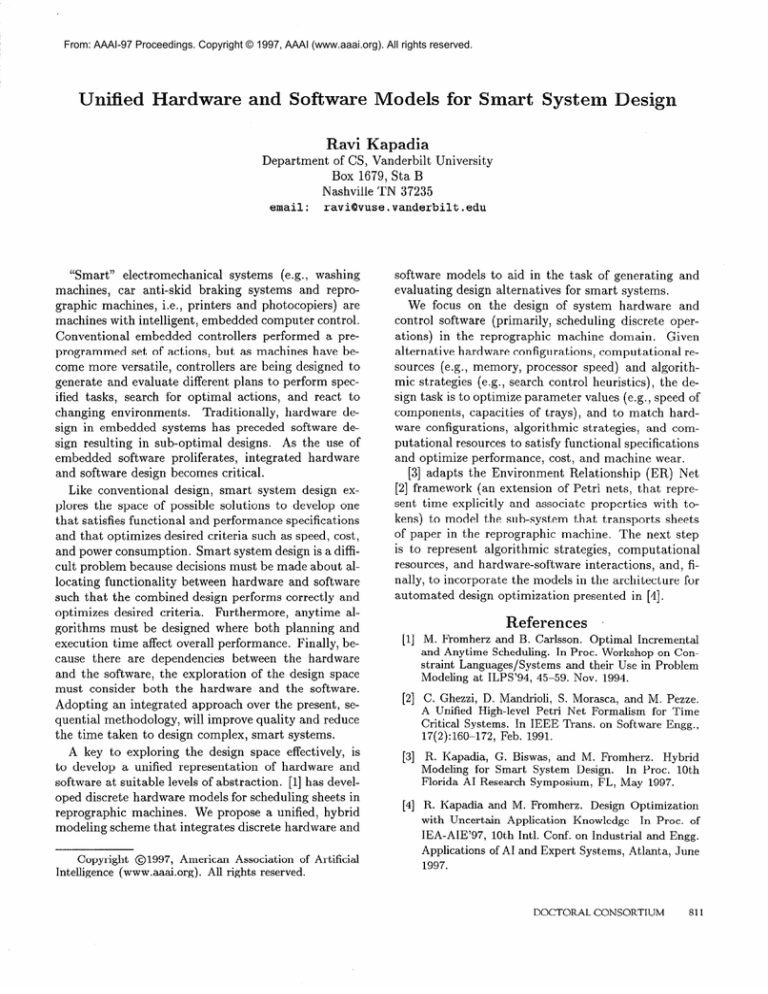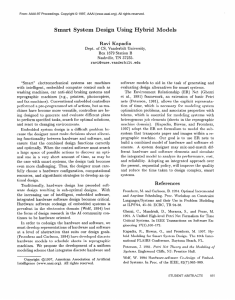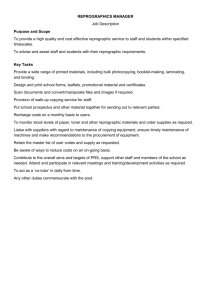
From: AAAI-97 Proceedings. Copyright © 1997, AAAI (www.aaai.org). All rights reserved.
Unified
ardware and Software
MO
mart Syste
esig
Ravi Kapadia
Department
email
:
of CS, Vanderbilt University
Box 1679, Sta B
Nashville TN 37235
raviQvuse.vanderbilt.edu
“Smart”
electromechanical
systems
(e.g., washing
machines,
car anti-skid braking systems and reprographic machines, i.e., printers and photocopiers)
are
machines with intelligent, embedded computer control.
Conventional
embedded controllers
performed a preprogrammed
set of actions, but as machines have become more versatile, controllers are being designed to
generate and evaluate different plans to perform specified tasks, search for optimal actions, and react to
Traditionally,
hardware dechanging environments.
sign in embedded systems has preceded software design resulting in sub-optimal
designs.
As the use of
embedded software proliferates,
integrated
hardware
and software design becomes critical.
Like conventional
design, smart system design explores the space of possible solutions to develop one
that satisfies functional and performance specifications
and that optimizes desired criteria such as speed, cost,
and power consumption.
Smart system design is a difficult problem because decisions must be made about allocating functionality
between hardware and software
such that the combined design performs correctly and
optimizes desired criteria.
Furthermore,
anytime algorithms must be designed where both planning and
execution time affect overall performance.
Finally, because there are dependencies
between the hardware
and the software, the exploration
of the design space
must consider both the hardware and the software.
Adopting an integrated approach over the present, sequential methodology,
will improve quality and reduce
the time taken to design complex, smart systems.
A key to exploring the design space effectively, is
to develop a unified representation
of hardware and
software at suitable levels of abstraction.
[l] has developed discrete hardware models for scheduling sheets in
reprographic
machines.
We propose a unified, hybrid
modeling scheme that integrates discrete hardware and
Copyright
01997,
American Association
of Artificial
Intelligence (www.aaai.org).
All rights reserved.
software models to aid in the task of generating
and
evaluating design alternatives for smart systems.
We focus on the design of system hardware and
control software (primarily, scheduling discrete operations) in the reprographic
machine domain.
Given
alternative hardware configurations,
computational
resources (e.g., memory, processor speed) and algorithmic strategies (e.g., search control heuristics),
the design task is to optimize parameter values (e.g., speed of
components,
capacities of trays), and to match hardware configurations,
algorithmic
strategies,
and computational resources to satisfy functional specifications
and optimize performance,
cost, and machine wear.
[3] adapts the Environment
Relationship
(ER) Net
[2] framework (an extension of Petri nets, that represent time explicitly and associate properties
with tokens) to model the sub-system
that transports
sheets
of paper in the reprographic
machine.
The next step
is to represent algorithmic
strategies,
computational
resources, and hardware-software
interactions,
and, finally, to incorporate the models in the architecture
for
automated design optimization
presented in [4].
References
M. Fromherz and B. Carlsson. Optimal Incremental
and Anytime Scheduling. In Proc. Workshop on Constraint Languages/Systems
and their Use in Problem
Modeling at ILPS’94, 45-59. Nov. 1994.
C. Ghezzi, D. Mandrioli, S. Morasca, and M. Pezze.
A Unified High-level Petri Net Formalism for Time
Critical Systems. In IEEE Trans. on Software Engg.,
17(2):160-172, Feb. 1991.
R. Kapadia, G. Biswas, and M. Fromherz.
Hybrid
Modeling for Smart System Design.
In Proc. 10th
Florida AI Research Symposium, FL, May 1997.
R. Kapadia
with
and M. Fromherz.
Uncertain
Application
Design
Optimization
Knowledge
In Proc.
IEA-AIE’97,
10th Intl. Conf. on Industrial
Applications
of AI and Expert
Systems,
of
and Engg.
Atlanta,
June
1997.
DOCTORAL CONSORTIUM
811





